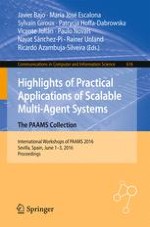2016 | Buch
Highlights of Practical Applications of Scalable Multi-Agent Systems. The PAAMS Collection
International Workshops of PAAMS 2016, Sevilla, Spain, June 1-3, 2016. Proceedings
herausgegeben von: Javier Bajo, María José Escalona, Sylvain Giroux, Patrycja Hoffa-Dąbrowska, Vicente Julián, Paulo Novais, Nayat Sánchez-Pi, Rainer Unland, Ricardo Azambuja-Silveira
Verlag: Springer International Publishing
Buchreihe : Communications in Computer and Information Science
